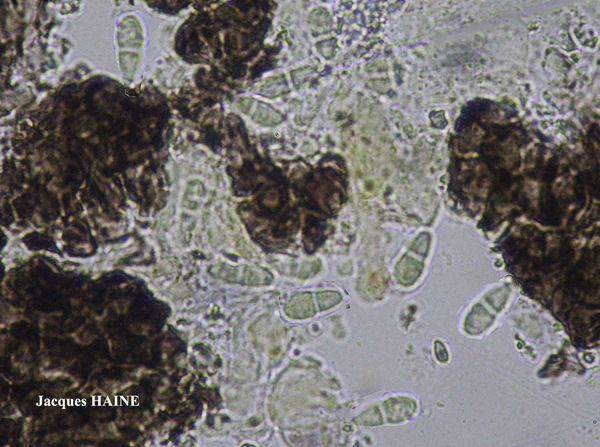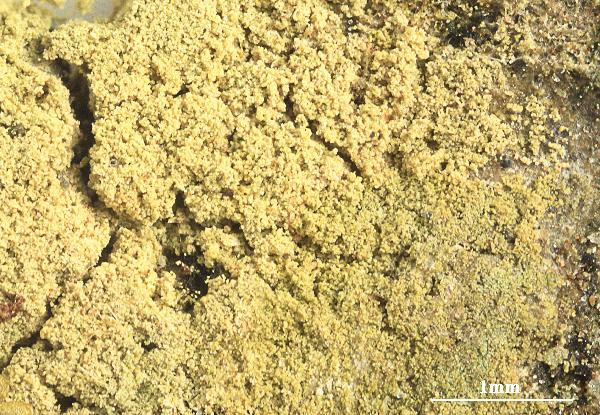Fellhanera viridisorediata Aptroot, M. Brand & Spier
Lichenologist, 30: 22, 1998
Synonyms:
Distribution:
Description: Thallus crustose, episubstratic, grey-green to green, sorediate, forming up to 10 cm wide patches; soralia at first punctiform, then raised and 0.1-0.2 mm high, crateriform and irregular in outline, often with vertical sides, sometimes confluent, grey-green with a bluish tinge (paler than thallus); soredia farinose, 20-30 µm in diam. Apothecia rare, biatorine, adnate to slightly stalked, rounded or irregularly flexuose in outline, (0.1-)0.3-0.7 mm across, with a flat to slightly convex, brown to dark brown disc, and a paler, pinkish brown to yellowish brown, persistent, flexuose proper margin. Proper exciple well developed, hyaline, paraplectenchymatous, with needle-like crystals, 20-30 µm wide laterally, 50-80 µm wide at base; epithecium pale brown, the colour disappearing in K; hymenium colourless, 40-80 µm high, I+ blue; paraphyses slender, 1-1.5 µm thick, branched and anastomosing, the apical cells slightly swollen; hypothecium pale brown, the colour disappearing in K. Asci 8-spored, clavate, with a K/I+ blue apical dome containing a darker blue, tubular ring-structure, and an amyloid coat, Byssoloma-type. Ascospores (0-)1-septate, often constricted at septum, hyaline, narrowly ellipsoid, the upper cell often slightly broader than the other, (12-)14-17 x 3.5-5(-6) µm, with a c. 1 µm thick gelatinous sheath. Pycnidia rare. Conidia 3-4 x 1.3-1.5 µm. Photobiont chlorococcoid. Spot tests: thallus K-, C-, KC-, P- UV-. Chemistry: thallus with variable amounts of roccellic acid, most abundant in the soralia (and in the exciple).Note: a recently-described, usually epiphytic species most frequent at the base of old trunks, but also found on living leaves, dead wood, pebbles, siliceous rocks and bricks in rather sheltered situations. Widespread in Europe, but apparently most common in its western parts, with a single record from the Eastern Alps (Germany); perhaps overlooked, being often sterile. To be looked for in Italy.
Growth form: Crustose
Substrata: rocks, bark, and lignum
Photobiont: green algae other than Trentepohlia
Reproductive strategy: mainly asexual, by soredia, or soredia-like structures (e.g. blastidia)
Most common in areas with a humid-warm climate (e.g. most of Tyrrenian Italy)
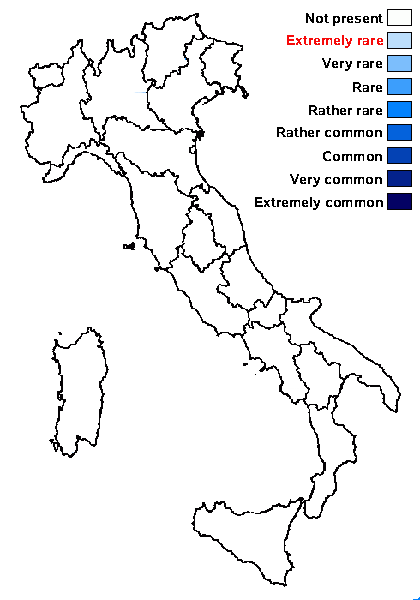
Predictive model
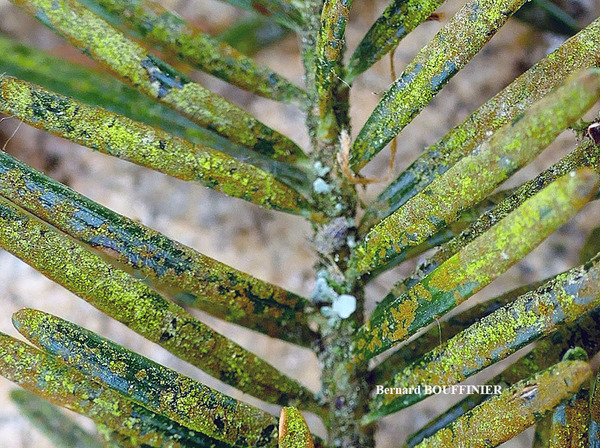
Bernard Bouffinier - Source: http://www.lichensmaritimes.org/index.php?task=fiche&lichen=878&lang=fr
France, Huelgoat, on Abies

Mark Powell - CC BY-SA NC
Herbarium: Holotype
Source:http://fungi.myspecies.info/all-fungi/fellhanera-viridisorediata
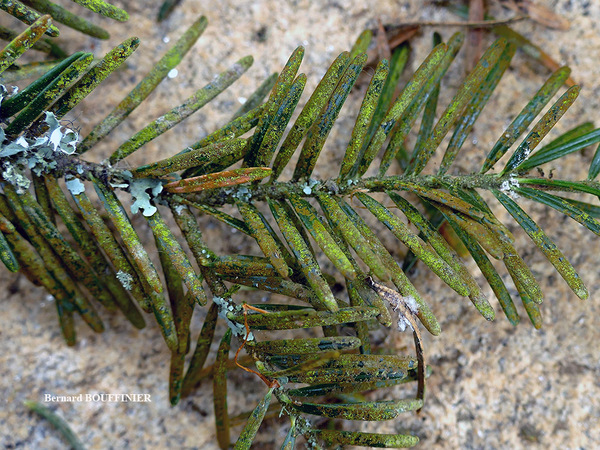
Bernard Bouffinier - Source: http://www.lichensmaritimes.org/index.php?task=fiche&lichen=878&lang=en
France, Huelgoat, on Abies
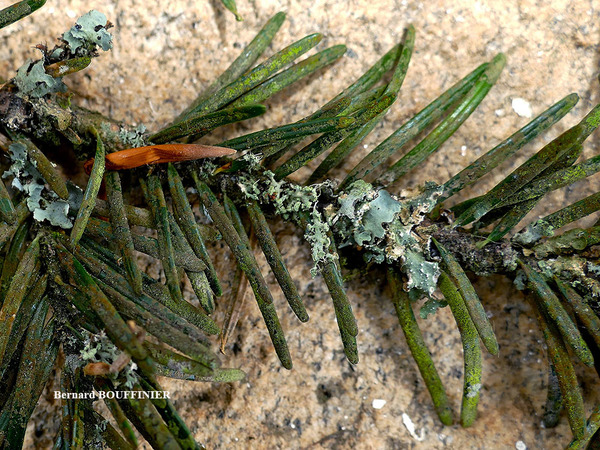
Bernard Bouffinier - Source: http://www.lichensmaritimes.org/index.php?task=fiche&lichen=878&lang=en
France, Huelgoat, on Abies
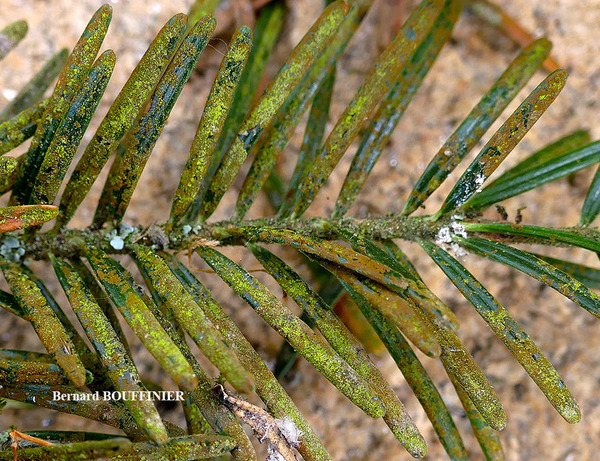
Bernard Bouffinier - Source: http://www.lichensmaritimes.org/index.php?task=fiche&lichen=878&lang=en
France, Huelgoat, on Abies
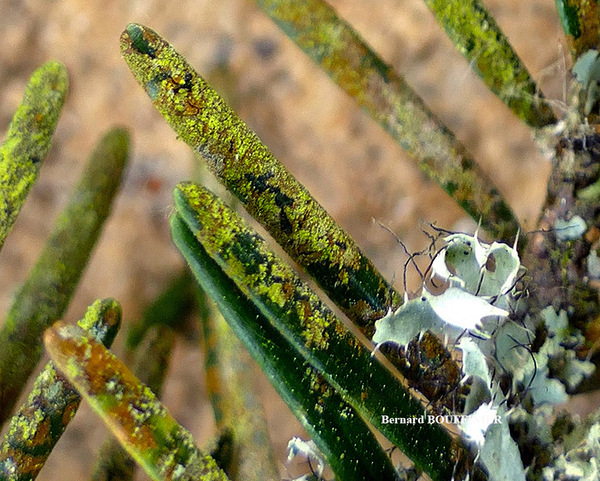
Bernard Bouffinier - Source: http://www.lichensmaritimes.org/index.php?task=fiche&lichen=878&lang=en
France, Huelgoat, on Abies
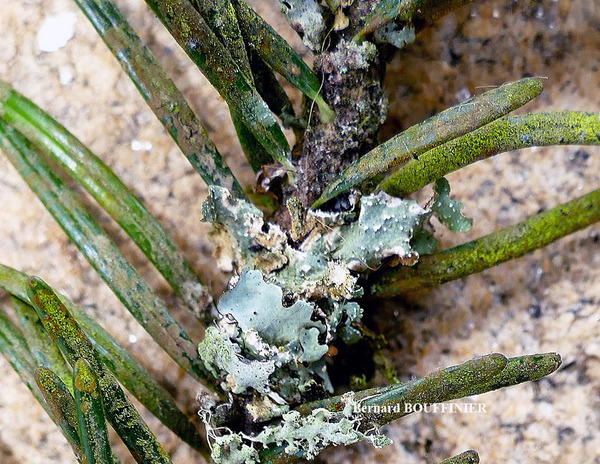
Bernard Bouffinier - Source: http://www.lichensmaritimes.org/index.php?task=fiche&lichen=878&lang=en
France, Huelgoat, on Abies
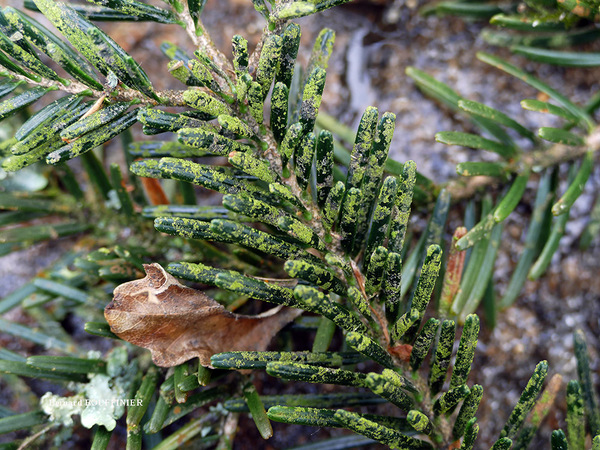
Bernard Bouffinier - Source: http://www.lichensmaritimes.org/index.php?task=fiche&lichen=878&lang=en
France, Huelgoat, on Abies
Growth form: Crustose
Substrata: rocks, bark, and lignum
Photobiont: green algae other than Trentepohlia
Reproductive strategy: mainly asexual, by soredia, or soredia-like structures (e.g. blastidia)
Most common in areas with a humid-warm climate (e.g. most of Tyrrenian Italy)

Predictive model

Bernard Bouffinier - Source: http://www.lichensmaritimes.org/index.php?task=fiche&lichen=878&lang=fr
France, Huelgoat, on Abies

Mark Powell - CC BY-SA NC
Herbarium: Holotype
Source:http://fungi.myspecies.info/all-fungi/fellhanera-viridisorediata

Bernard Bouffinier - Source: http://www.lichensmaritimes.org/index.php?task=fiche&lichen=878&lang=en
France, Huelgoat, on Abies

Bernard Bouffinier - Source: http://www.lichensmaritimes.org/index.php?task=fiche&lichen=878&lang=en
France, Huelgoat, on Abies

Bernard Bouffinier - Source: http://www.lichensmaritimes.org/index.php?task=fiche&lichen=878&lang=en
France, Huelgoat, on Abies

Bernard Bouffinier - Source: http://www.lichensmaritimes.org/index.php?task=fiche&lichen=878&lang=en
France, Huelgoat, on Abies

Bernard Bouffinier - Source: http://www.lichensmaritimes.org/index.php?task=fiche&lichen=878&lang=en
France, Huelgoat, on Abies

 INDEX FUNGORUM
INDEX FUNGORUM
 GBIF
GBIF
